Human Resource Management Report: Pakistan Tobacco Company
VerifiedAdded on 2022/05/17
|38
|8039
|329
Report
AI Summary
This report provides an in-depth analysis of the Human Resource Management (HRM) practices at Pakistan Tobacco Company (PTC). It begins with an overview of PTC, its history, brands, and employee benefits, followed by an examination of the purpose of HRM, especially in workforce planning. The report delves into the functions of HRM, including recruitment, maintaining a positive work environment, training and development, compensation and benefits, achieving organizational goals, and employee-employer relations. It further explores workforce planning, emphasizing its importance and benefits. The report then discusses the strengths and weaknesses of different recruitment approaches, HRM practices for both employers and employees, employee relations, employment legislation, and job descriptions. It also includes tailored CVs, shortlisting interview notes, and job offers, concluding with an evaluation of HRM practices and their rationale for recruitment and selection. The assignment is based on the Pearson BTEC Higher National Diploma in Business, Unit 03: Human Resource Management (Level 4).
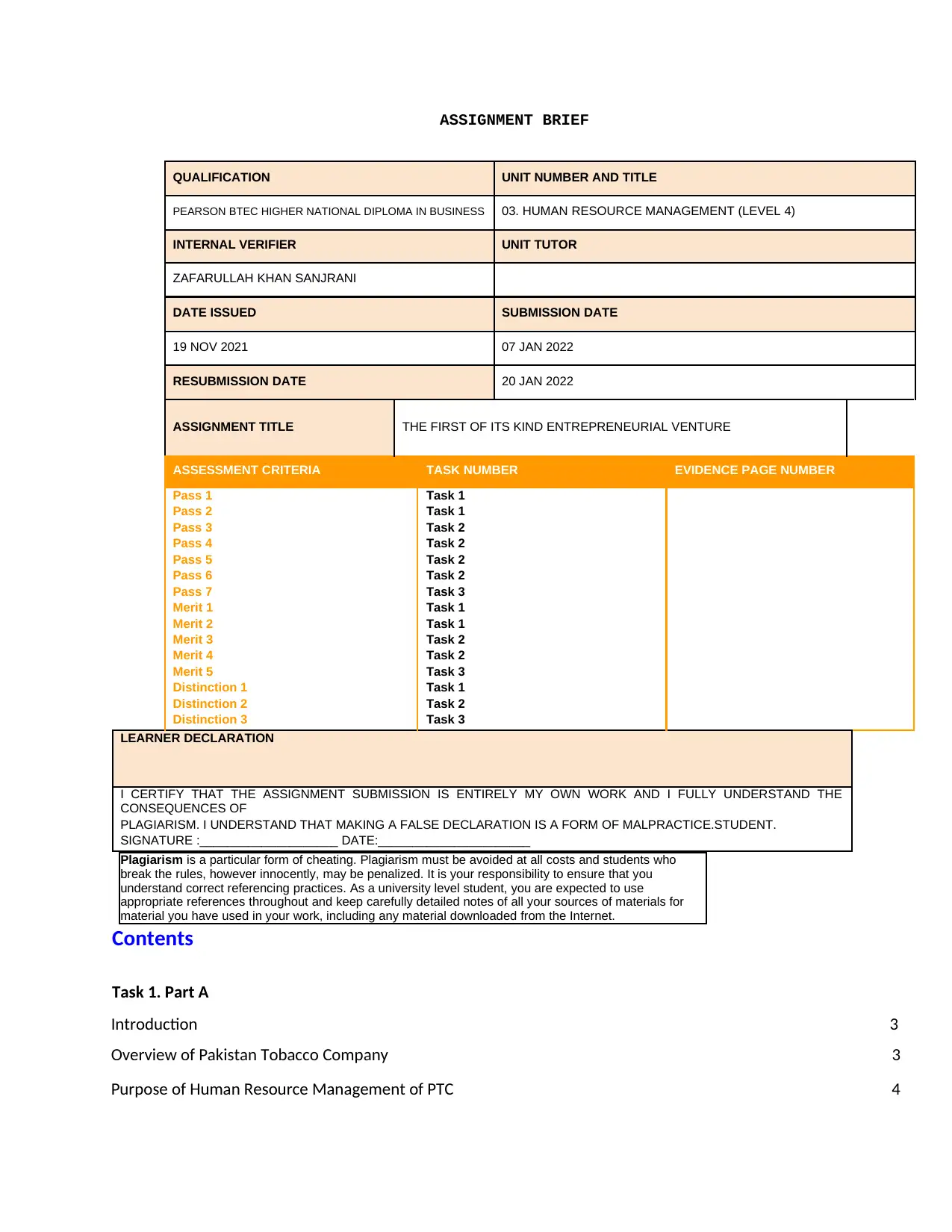
ASSIGNMENT BRIEF
QUALIFICATION UNIT NUMBER AND TITLE
PEARSON BTEC HIGHER NATIONAL DIPLOMA IN BUSINESS 03. HUMAN RESOURCE MANAGEMENT (LEVEL 4)
INTERNAL VERIFIER UNIT TUTOR
ZAFARULLAH KHAN SANJRANI
DATE ISSUED SUBMISSION DATE
19 NOV 2021 07 JAN 2022
RESUBMISSION DATE 20 JAN 2022
ASSIGNMENT TITLE THE FIRST OF ITS KIND ENTREPRENEURIAL VENTURE
ASSESSMENT CRITERIA TASK NUMBER EVIDENCE PAGE NUMBER
Pass 1
Pass 2
Pass 3
Pass 4
Pass 5
Pass 6
Pass 7
Merit 1
Merit 2
Merit 3
Merit 4
Merit 5
Distinction 1
Distinction 2
Distinction 3
Task 1
Task 1
Task 2
Task 2
Task 2
Task 2
Task 3
Task 1
Task 1
Task 2
Task 2
Task 3
Task 1
Task 2
Task 3
LEARNER DECLARATION
I CERTIFY THAT THE ASSIGNMENT SUBMISSION IS ENTIRELY MY OWN WORK AND I FULLY UNDERSTAND THE
CONSEQUENCES OF
PLAGIARISM. I UNDERSTAND THAT MAKING A FALSE DECLARATION IS A FORM OF MALPRACTICE.STUDENT.
SIGNATURE :____________________ DATE:______________________
Plagiarism is a particular form of cheating. Plagiarism must be avoided at all costs and students who
break the rules, however innocently, may be penalized. It is your responsibility to ensure that you
understand correct referencing practices. As a university level student, you are expected to use
appropriate references throughout and keep carefully detailed notes of all your sources of materials for
material you have used in your work, including any material downloaded from the Internet.
Contents
Task 1. Part A
Introduction 3
Overview of Pakistan Tobacco Company 3
Purpose of Human Resource Management of PTC 4
QUALIFICATION UNIT NUMBER AND TITLE
PEARSON BTEC HIGHER NATIONAL DIPLOMA IN BUSINESS 03. HUMAN RESOURCE MANAGEMENT (LEVEL 4)
INTERNAL VERIFIER UNIT TUTOR
ZAFARULLAH KHAN SANJRANI
DATE ISSUED SUBMISSION DATE
19 NOV 2021 07 JAN 2022
RESUBMISSION DATE 20 JAN 2022
ASSIGNMENT TITLE THE FIRST OF ITS KIND ENTREPRENEURIAL VENTURE
ASSESSMENT CRITERIA TASK NUMBER EVIDENCE PAGE NUMBER
Pass 1
Pass 2
Pass 3
Pass 4
Pass 5
Pass 6
Pass 7
Merit 1
Merit 2
Merit 3
Merit 4
Merit 5
Distinction 1
Distinction 2
Distinction 3
Task 1
Task 1
Task 2
Task 2
Task 2
Task 2
Task 3
Task 1
Task 1
Task 2
Task 2
Task 3
Task 1
Task 2
Task 3
LEARNER DECLARATION
I CERTIFY THAT THE ASSIGNMENT SUBMISSION IS ENTIRELY MY OWN WORK AND I FULLY UNDERSTAND THE
CONSEQUENCES OF
PLAGIARISM. I UNDERSTAND THAT MAKING A FALSE DECLARATION IS A FORM OF MALPRACTICE.STUDENT.
SIGNATURE :____________________ DATE:______________________
Plagiarism is a particular form of cheating. Plagiarism must be avoided at all costs and students who
break the rules, however innocently, may be penalized. It is your responsibility to ensure that you
understand correct referencing practices. As a university level student, you are expected to use
appropriate references throughout and keep carefully detailed notes of all your sources of materials for
material you have used in your work, including any material downloaded from the Internet.
Contents
Task 1. Part A
Introduction 3
Overview of Pakistan Tobacco Company 3
Purpose of Human Resource Management of PTC 4
Paraphrase This Document
Need a fresh take? Get an instant paraphrase of this document with our AI Paraphraser
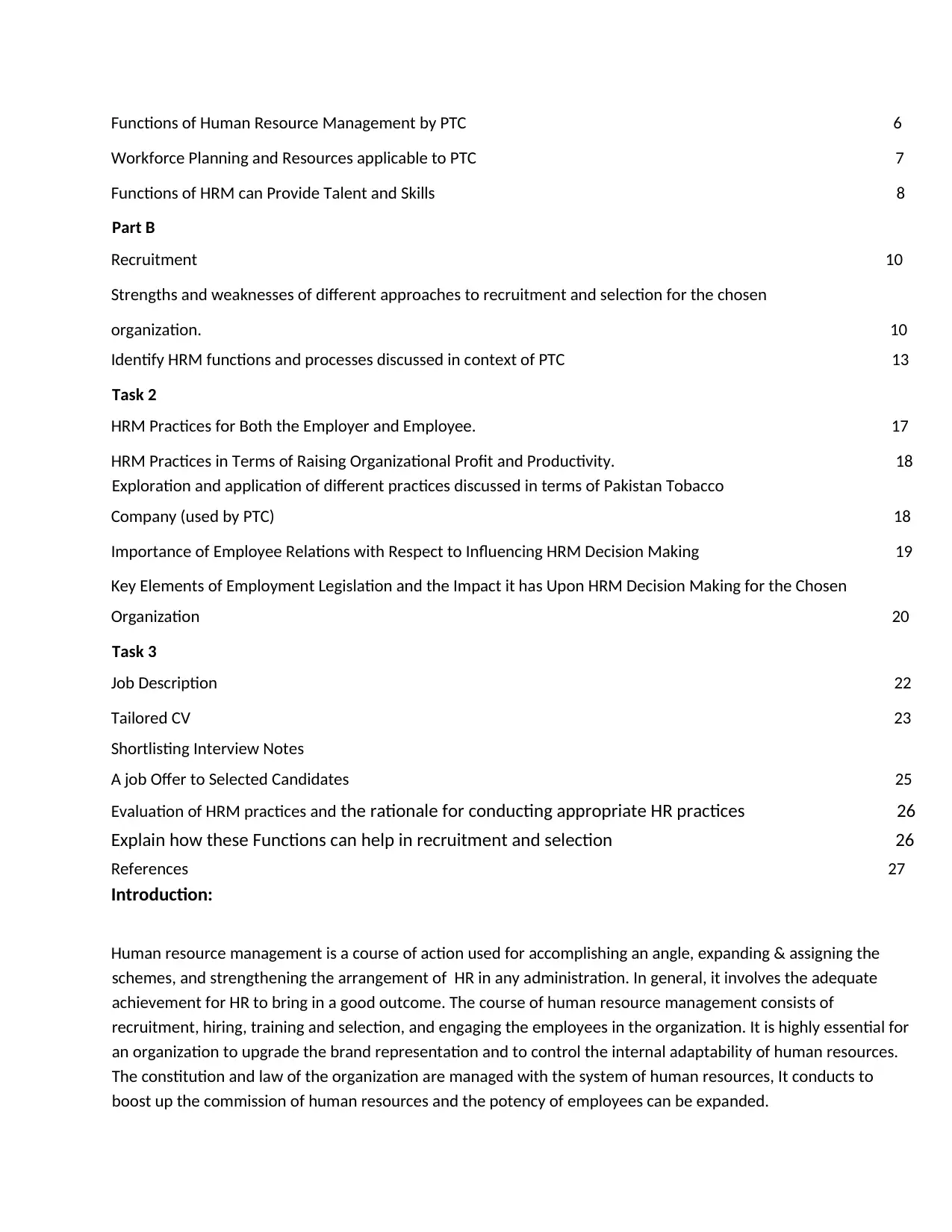
Functions of Human Resource Management by PTC 6
Workforce Planning and Resources applicable to PTC 7
Functions of HRM can Provide Talent and Skills 8
Part B
Recruitment 10
Strengths and weaknesses of different approaches to recruitment and selection for the chosen
organization. 10
Identify HRM functions and processes discussed in context of PTC 13
Task 2
HRM Practices for Both the Employer and Employee. 17
HRM Practices in Terms of Raising Organizational Profit and Productivity. 18
Exploration and application of different practices discussed in terms of Pakistan Tobacco
Company (used by PTC) 18
Importance of Employee Relations with Respect to Influencing HRM Decision Making 19
Key Elements of Employment Legislation and the Impact it has Upon HRM Decision Making for the Chosen
Organization 20
Task 3
Job Description 22
Tailored CV 23
Shortlisting Interview Notes
A job Offer to Selected Candidates 25
Evaluation of HRM practices and the rationale for conducting appropriate HR practices 26
Explain how these Functions can help in recruitment and selection 26
References 27
Introduction:
Human resource management is a course of action used for accomplishing an angle, expanding & assigning the
schemes, and strengthening the arrangement of HR in any administration. In general, it involves the adequate
achievement for HR to bring in a good outcome. The course of human resource management consists of
recruitment, hiring, training and selection, and engaging the employees in the organization. It is highly essential for
an organization to upgrade the brand representation and to control the internal adaptability of human resources.
The constitution and law of the organization are managed with the system of human resources, It conducts to
boost up the commission of human resources and the potency of employees can be expanded.
Workforce Planning and Resources applicable to PTC 7
Functions of HRM can Provide Talent and Skills 8
Part B
Recruitment 10
Strengths and weaknesses of different approaches to recruitment and selection for the chosen
organization. 10
Identify HRM functions and processes discussed in context of PTC 13
Task 2
HRM Practices for Both the Employer and Employee. 17
HRM Practices in Terms of Raising Organizational Profit and Productivity. 18
Exploration and application of different practices discussed in terms of Pakistan Tobacco
Company (used by PTC) 18
Importance of Employee Relations with Respect to Influencing HRM Decision Making 19
Key Elements of Employment Legislation and the Impact it has Upon HRM Decision Making for the Chosen
Organization 20
Task 3
Job Description 22
Tailored CV 23
Shortlisting Interview Notes
A job Offer to Selected Candidates 25
Evaluation of HRM practices and the rationale for conducting appropriate HR practices 26
Explain how these Functions can help in recruitment and selection 26
References 27
Introduction:
Human resource management is a course of action used for accomplishing an angle, expanding & assigning the
schemes, and strengthening the arrangement of HR in any administration. In general, it involves the adequate
achievement for HR to bring in a good outcome. The course of human resource management consists of
recruitment, hiring, training and selection, and engaging the employees in the organization. It is highly essential for
an organization to upgrade the brand representation and to control the internal adaptability of human resources.
The constitution and law of the organization are managed with the system of human resources, It conducts to
boost up the commission of human resources and the potency of employees can be expanded.
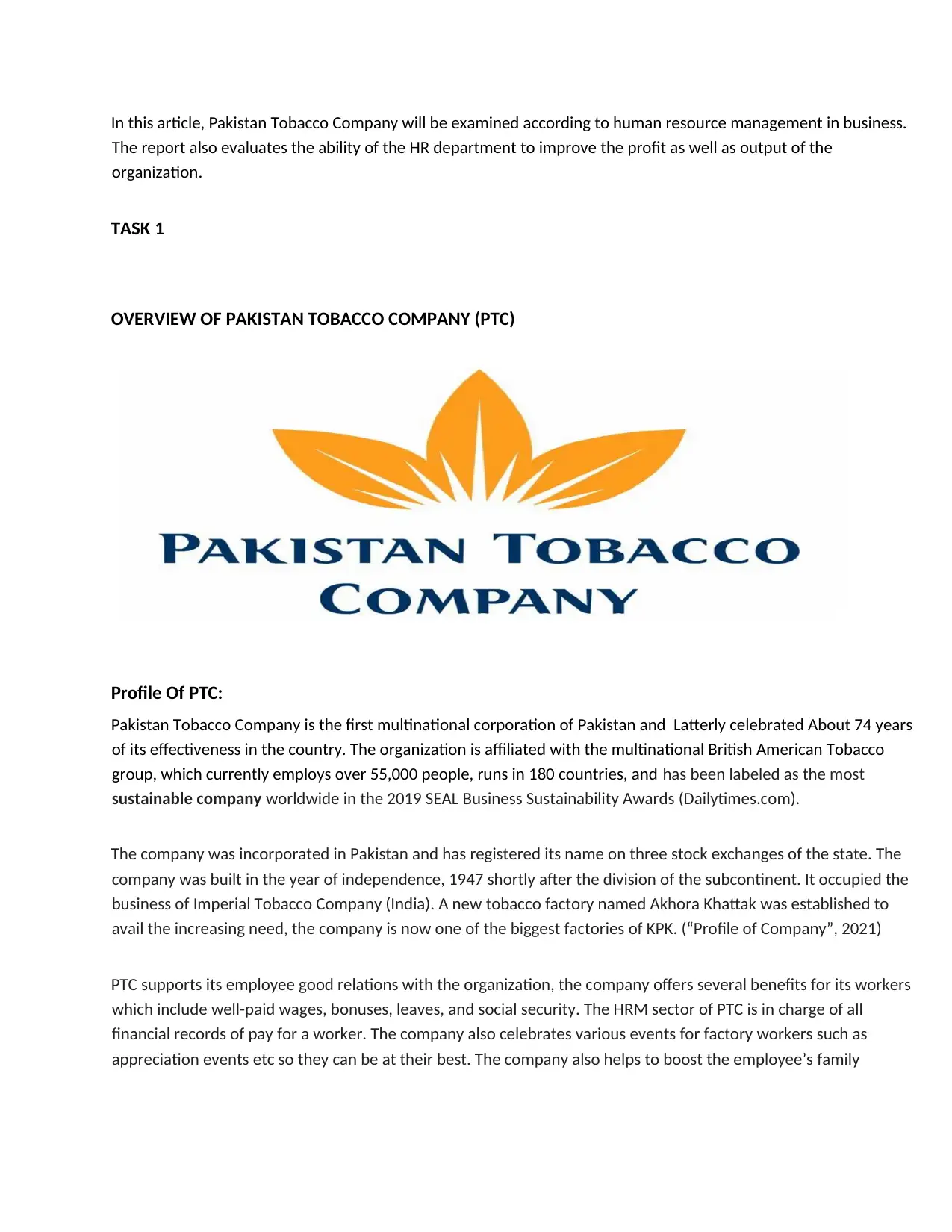
In this article, Pakistan Tobacco Company will be examined according to human resource management in business.
The report also evaluates the ability of the HR department to improve the profit as well as output of the
organization.
TASK 1
OVERVIEW OF PAKISTAN TOBACCO COMPANY (PTC)
Profile Of PTC:
Pakistan Tobacco Company is the first multinational corporation of Pakistan and Latterly celebrated About 74 years
of its effectiveness in the country. The organization is affiliated with the multinational British American Tobacco
group, which currently employs over 55,000 people, runs in 180 countries, and has been labeled as the most
sustainable company worldwide in the 2019 SEAL Business Sustainability Awards (Dailytimes.com).
The company was incorporated in Pakistan and has registered its name on three stock exchanges of the state. The
company was built in the year of independence, 1947 shortly after the division of the subcontinent. It occupied the
business of Imperial Tobacco Company (India). A new tobacco factory named Akhora Khattak was established to
avail the increasing need, the company is now one of the biggest factories of KPK. (“Profile of Company”, 2021)
PTC supports its employee good relations with the organization, the company offers several benefits for its workers
which include well-paid wages, bonuses, leaves, and social security. The HRM sector of PTC is in charge of all
financial records of pay for a worker. The company also celebrates various events for factory workers such as
appreciation events etc so they can be at their best. The company also helps to boost the employee’s family
The report also evaluates the ability of the HR department to improve the profit as well as output of the
organization.
TASK 1
OVERVIEW OF PAKISTAN TOBACCO COMPANY (PTC)
Profile Of PTC:
Pakistan Tobacco Company is the first multinational corporation of Pakistan and Latterly celebrated About 74 years
of its effectiveness in the country. The organization is affiliated with the multinational British American Tobacco
group, which currently employs over 55,000 people, runs in 180 countries, and has been labeled as the most
sustainable company worldwide in the 2019 SEAL Business Sustainability Awards (Dailytimes.com).
The company was incorporated in Pakistan and has registered its name on three stock exchanges of the state. The
company was built in the year of independence, 1947 shortly after the division of the subcontinent. It occupied the
business of Imperial Tobacco Company (India). A new tobacco factory named Akhora Khattak was established to
avail the increasing need, the company is now one of the biggest factories of KPK. (“Profile of Company”, 2021)
PTC supports its employee good relations with the organization, the company offers several benefits for its workers
which include well-paid wages, bonuses, leaves, and social security. The HRM sector of PTC is in charge of all
financial records of pay for a worker. The company also celebrates various events for factory workers such as
appreciation events etc so they can be at their best. The company also helps to boost the employee’s family
⊘ This is a preview!⊘
Do you want full access?
Subscribe today to unlock all pages.

Trusted by 1+ million students worldwide
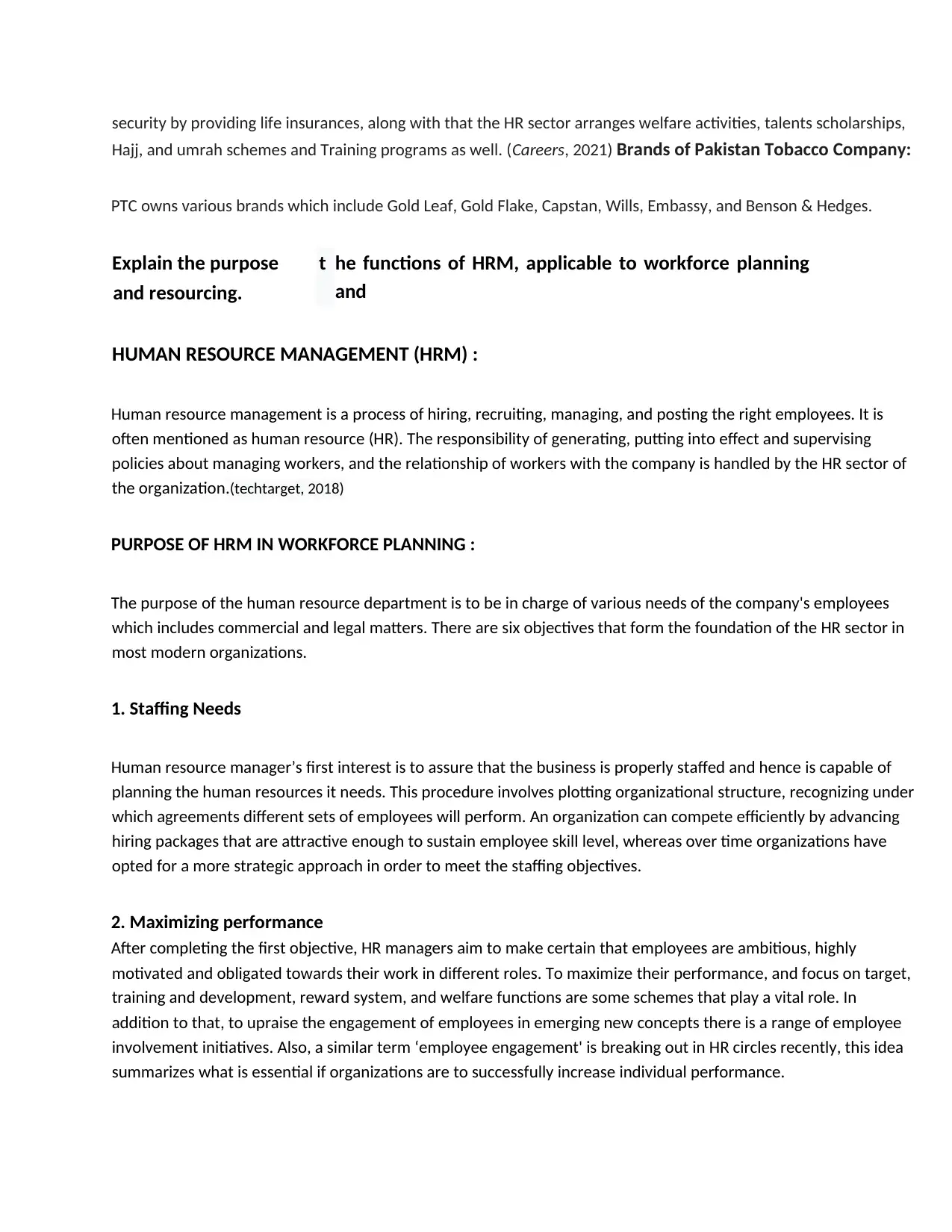
security by providing life insurances, along with that the HR sector arranges welfare activities, talents scholarships,
Hajj, and umrah schemes and Training programs as well. (Careers, 2021) Brands of Pakistan Tobacco Company:
PTC owns various brands which include Gold Leaf, Gold Flake, Capstan, Wills, Embassy, and Benson & Hedges.
Explain the purpose
and resourcing.
HUMAN RESOURCE MANAGEMENT (HRM) :
Human resource management is a process of hiring, recruiting, managing, and posting the right employees. It is
often mentioned as human resource (HR). The responsibility of generating, putting into effect and supervising
policies about managing workers, and the relationship of workers with the company is handled by the HR sector of
the organization.(techtarget, 2018)
PURPOSE OF HRM IN WORKFORCE PLANNING :
The purpose of the human resource department is to be in charge of various needs of the company's employees
which includes commercial and legal matters. There are six objectives that form the foundation of the HR sector in
most modern organizations.
1. Staffing Needs
Human resource manager’s first interest is to assure that the business is properly staffed and hence is capable of
planning the human resources it needs. This procedure involves plotting organizational structure, recognizing under
which agreements different sets of employees will perform. An organization can compete efficiently by advancing
hiring packages that are attractive enough to sustain employee skill level, whereas over time organizations have
opted for a more strategic approach in order to meet the staffing objectives.
2. Maximizing performance
After completing the first objective, HR managers aim to make certain that employees are ambitious, highly
motivated and obligated towards their work in different roles. To maximize their performance, and focus on target,
training and development, reward system, and welfare functions are some schemes that play a vital role. In
addition to that, to upraise the engagement of employees in emerging new concepts there is a range of employee
involvement initiatives. Also, a similar term ‘employee engagement' is breaking out in HR circles recently, this idea
summarizes what is essential if organizations are to successfully increase individual performance.
t he functions of HRM, applicable to workforce planning
and
Hajj, and umrah schemes and Training programs as well. (Careers, 2021) Brands of Pakistan Tobacco Company:
PTC owns various brands which include Gold Leaf, Gold Flake, Capstan, Wills, Embassy, and Benson & Hedges.
Explain the purpose
and resourcing.
HUMAN RESOURCE MANAGEMENT (HRM) :
Human resource management is a process of hiring, recruiting, managing, and posting the right employees. It is
often mentioned as human resource (HR). The responsibility of generating, putting into effect and supervising
policies about managing workers, and the relationship of workers with the company is handled by the HR sector of
the organization.(techtarget, 2018)
PURPOSE OF HRM IN WORKFORCE PLANNING :
The purpose of the human resource department is to be in charge of various needs of the company's employees
which includes commercial and legal matters. There are six objectives that form the foundation of the HR sector in
most modern organizations.
1. Staffing Needs
Human resource manager’s first interest is to assure that the business is properly staffed and hence is capable of
planning the human resources it needs. This procedure involves plotting organizational structure, recognizing under
which agreements different sets of employees will perform. An organization can compete efficiently by advancing
hiring packages that are attractive enough to sustain employee skill level, whereas over time organizations have
opted for a more strategic approach in order to meet the staffing objectives.
2. Maximizing performance
After completing the first objective, HR managers aim to make certain that employees are ambitious, highly
motivated and obligated towards their work in different roles. To maximize their performance, and focus on target,
training and development, reward system, and welfare functions are some schemes that play a vital role. In
addition to that, to upraise the engagement of employees in emerging new concepts there is a range of employee
involvement initiatives. Also, a similar term ‘employee engagement' is breaking out in HR circles recently, this idea
summarizes what is essential if organizations are to successfully increase individual performance.
t he functions of HRM, applicable to workforce planning
and
Paraphrase This Document
Need a fresh take? Get an instant paraphrase of this document with our AI Paraphraser
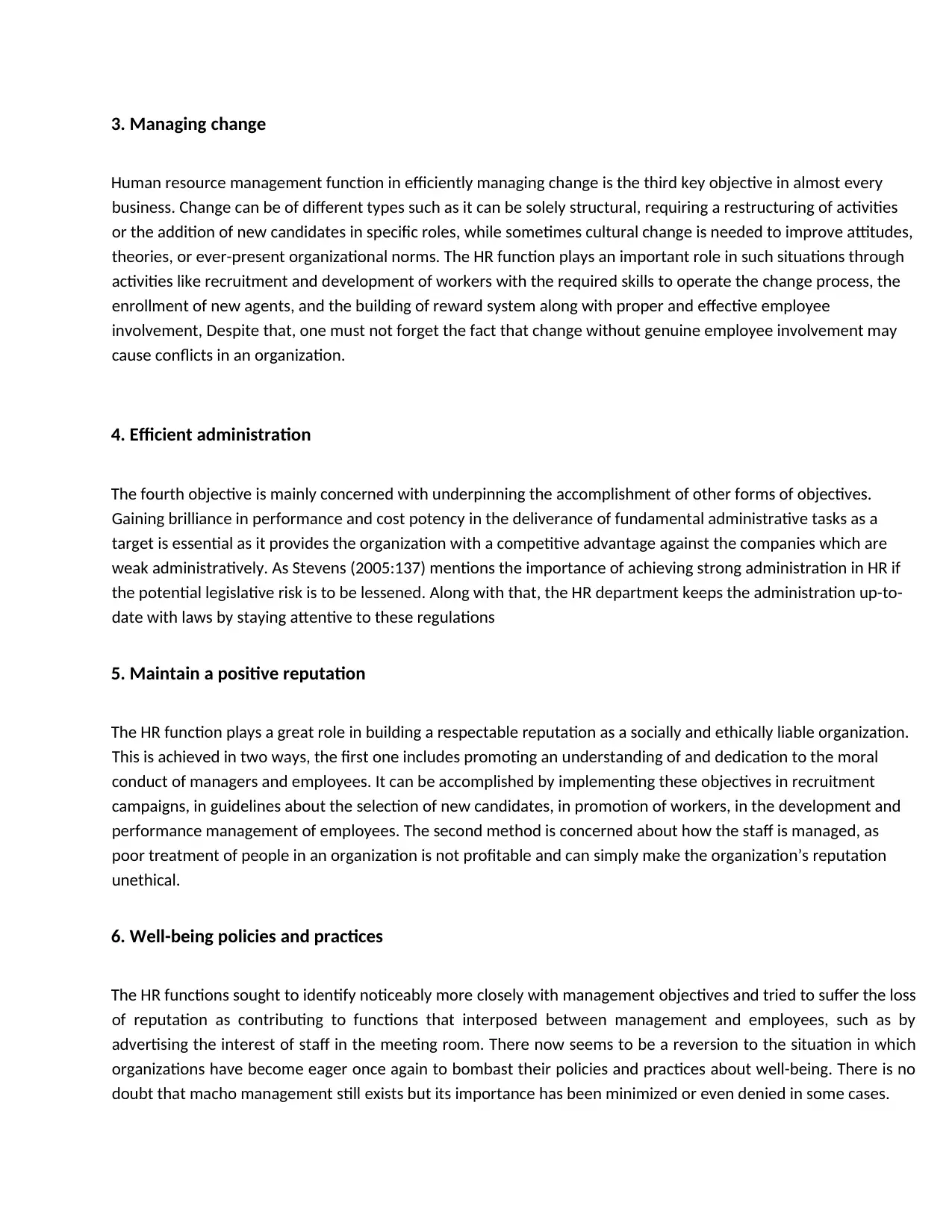
3. Managing change
Human resource management function in efficiently managing change is the third key objective in almost every
business. Change can be of different types such as it can be solely structural, requiring a restructuring of activities
or the addition of new candidates in specific roles, while sometimes cultural change is needed to improve attitudes,
theories, or ever-present organizational norms. The HR function plays an important role in such situations through
activities like recruitment and development of workers with the required skills to operate the change process, the
enrollment of new agents, and the building of reward system along with proper and effective employee
involvement, Despite that, one must not forget the fact that change without genuine employee involvement may
cause conflicts in an organization.
4. Efficient administration
The fourth objective is mainly concerned with underpinning the accomplishment of other forms of objectives.
Gaining brilliance in performance and cost potency in the deliverance of fundamental administrative tasks as a
target is essential as it provides the organization with a competitive advantage against the companies which are
weak administratively. As Stevens (2005:137) mentions the importance of achieving strong administration in HR if
the potential legislative risk is to be lessened. Along with that, the HR department keeps the administration up-to-
date with laws by staying attentive to these regulations
5. Maintain a positive reputation
The HR function plays a great role in building a respectable reputation as a socially and ethically liable organization.
This is achieved in two ways, the first one includes promoting an understanding of and dedication to the moral
conduct of managers and employees. It can be accomplished by implementing these objectives in recruitment
campaigns, in guidelines about the selection of new candidates, in promotion of workers, in the development and
performance management of employees. The second method is concerned about how the staff is managed, as
poor treatment of people in an organization is not profitable and can simply make the organization’s reputation
unethical.
6. Well-being policies and practices
The HR functions sought to identify noticeably more closely with management objectives and tried to suffer the loss
of reputation as contributing to functions that interposed between management and employees, such as by
advertising the interest of staff in the meeting room. There now seems to be a reversion to the situation in which
organizations have become eager once again to bombast their policies and practices about well-being. There is no
doubt that macho management still exists but its importance has been minimized or even denied in some cases.
Human resource management function in efficiently managing change is the third key objective in almost every
business. Change can be of different types such as it can be solely structural, requiring a restructuring of activities
or the addition of new candidates in specific roles, while sometimes cultural change is needed to improve attitudes,
theories, or ever-present organizational norms. The HR function plays an important role in such situations through
activities like recruitment and development of workers with the required skills to operate the change process, the
enrollment of new agents, and the building of reward system along with proper and effective employee
involvement, Despite that, one must not forget the fact that change without genuine employee involvement may
cause conflicts in an organization.
4. Efficient administration
The fourth objective is mainly concerned with underpinning the accomplishment of other forms of objectives.
Gaining brilliance in performance and cost potency in the deliverance of fundamental administrative tasks as a
target is essential as it provides the organization with a competitive advantage against the companies which are
weak administratively. As Stevens (2005:137) mentions the importance of achieving strong administration in HR if
the potential legislative risk is to be lessened. Along with that, the HR department keeps the administration up-to-
date with laws by staying attentive to these regulations
5. Maintain a positive reputation
The HR function plays a great role in building a respectable reputation as a socially and ethically liable organization.
This is achieved in two ways, the first one includes promoting an understanding of and dedication to the moral
conduct of managers and employees. It can be accomplished by implementing these objectives in recruitment
campaigns, in guidelines about the selection of new candidates, in promotion of workers, in the development and
performance management of employees. The second method is concerned about how the staff is managed, as
poor treatment of people in an organization is not profitable and can simply make the organization’s reputation
unethical.
6. Well-being policies and practices
The HR functions sought to identify noticeably more closely with management objectives and tried to suffer the loss
of reputation as contributing to functions that interposed between management and employees, such as by
advertising the interest of staff in the meeting room. There now seems to be a reversion to the situation in which
organizations have become eager once again to bombast their policies and practices about well-being. There is no
doubt that macho management still exists but its importance has been minimized or even denied in some cases.
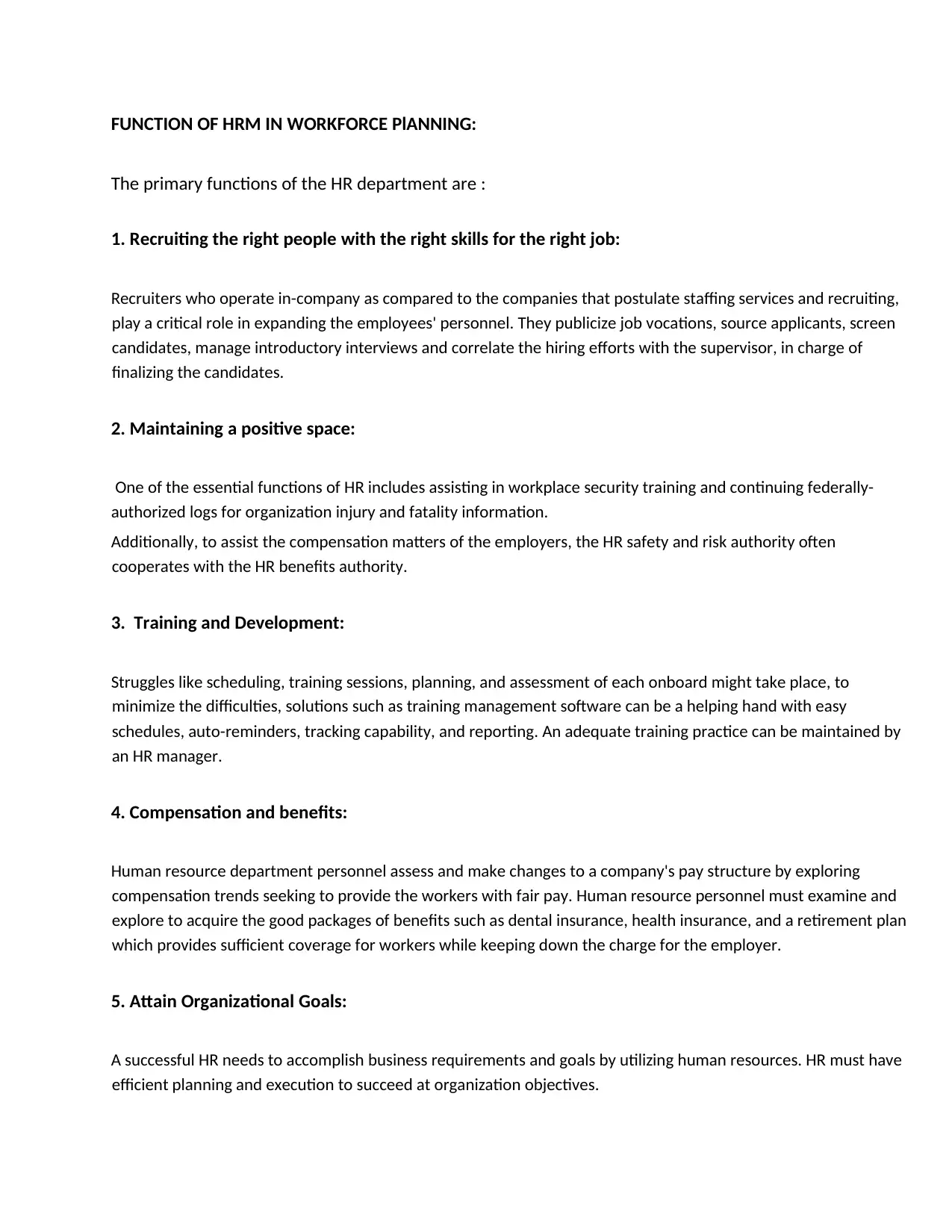
FUNCTION OF HRM IN WORKFORCE PlANNING:
The primary functions of the HR department are :
1. Recruiting the right people with the right skills for the right job:
Recruiters who operate in-company as compared to the companies that postulate staffing services and recruiting,
play a critical role in expanding the employees' personnel. They publicize job vocations, source applicants, screen
candidates, manage introductory interviews and correlate the hiring efforts with the supervisor, in charge of
finalizing the candidates.
2. Maintaining a positive space:
One of the essential functions of HR includes assisting in workplace security training and continuing federally-
authorized logs for organization injury and fatality information.
Additionally, to assist the compensation matters of the employers, the HR safety and risk authority often
cooperates with the HR benefits authority.
3. Training and Development:
Struggles like scheduling, training sessions, planning, and assessment of each onboard might take place, to
minimize the difficulties, solutions such as training management software can be a helping hand with easy
schedules, auto-reminders, tracking capability, and reporting. An adequate training practice can be maintained by
an HR manager.
4. Compensation and benefits:
Human resource department personnel assess and make changes to a company's pay structure by exploring
compensation trends seeking to provide the workers with fair pay. Human resource personnel must examine and
explore to acquire the good packages of benefits such as dental insurance, health insurance, and a retirement plan
which provides sufficient coverage for workers while keeping down the charge for the employer.
5. Attain Organizational Goals:
A successful HR needs to accomplish business requirements and goals by utilizing human resources. HR must have
efficient planning and execution to succeed at organization objectives.
The primary functions of the HR department are :
1. Recruiting the right people with the right skills for the right job:
Recruiters who operate in-company as compared to the companies that postulate staffing services and recruiting,
play a critical role in expanding the employees' personnel. They publicize job vocations, source applicants, screen
candidates, manage introductory interviews and correlate the hiring efforts with the supervisor, in charge of
finalizing the candidates.
2. Maintaining a positive space:
One of the essential functions of HR includes assisting in workplace security training and continuing federally-
authorized logs for organization injury and fatality information.
Additionally, to assist the compensation matters of the employers, the HR safety and risk authority often
cooperates with the HR benefits authority.
3. Training and Development:
Struggles like scheduling, training sessions, planning, and assessment of each onboard might take place, to
minimize the difficulties, solutions such as training management software can be a helping hand with easy
schedules, auto-reminders, tracking capability, and reporting. An adequate training practice can be maintained by
an HR manager.
4. Compensation and benefits:
Human resource department personnel assess and make changes to a company's pay structure by exploring
compensation trends seeking to provide the workers with fair pay. Human resource personnel must examine and
explore to acquire the good packages of benefits such as dental insurance, health insurance, and a retirement plan
which provides sufficient coverage for workers while keeping down the charge for the employer.
5. Attain Organizational Goals:
A successful HR needs to accomplish business requirements and goals by utilizing human resources. HR must have
efficient planning and execution to succeed at organization objectives.
⊘ This is a preview!⊘
Do you want full access?
Subscribe today to unlock all pages.

Trusted by 1+ million students worldwide
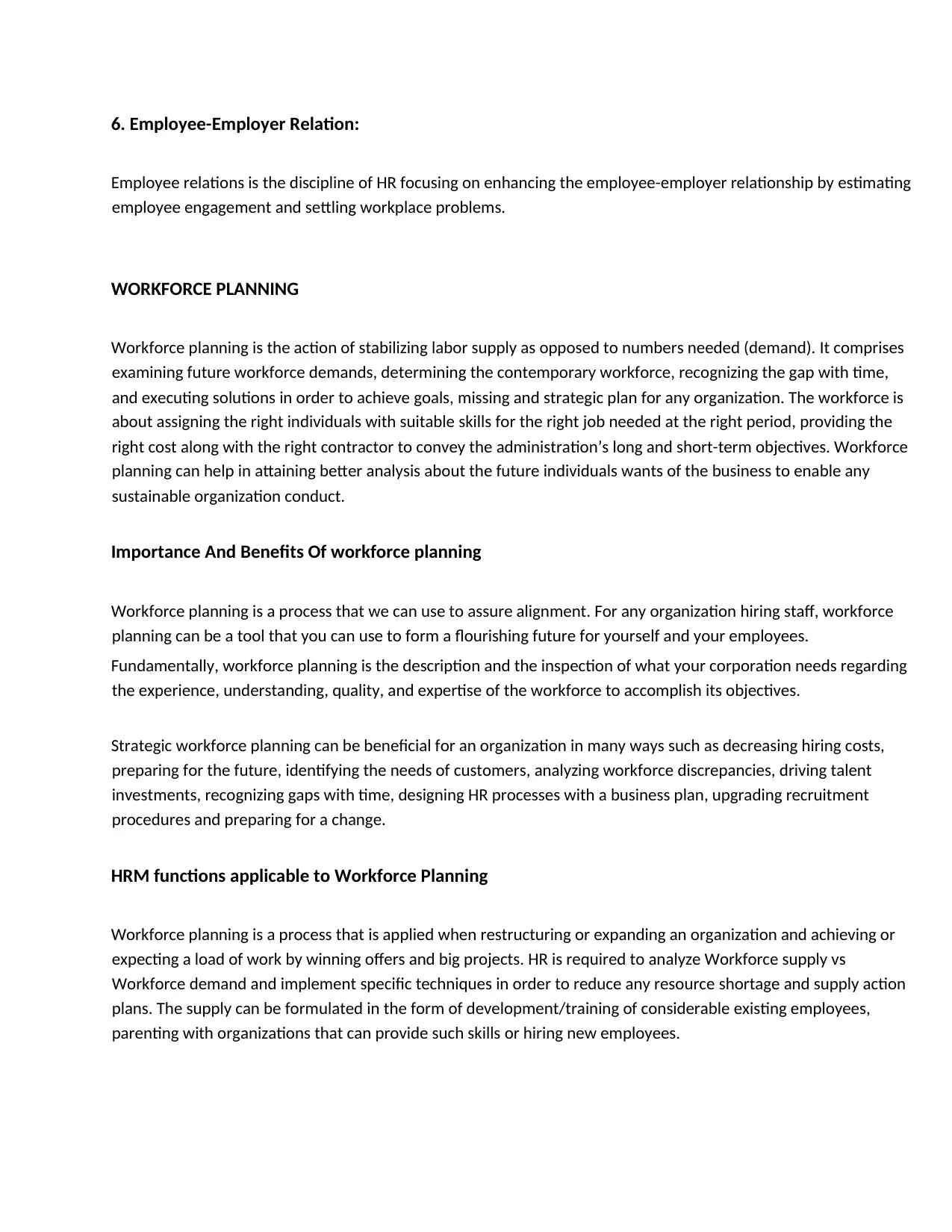
6. Employee-Employer Relation:
Employee relations is the discipline of HR focusing on enhancing the employee-employer relationship by estimating
employee engagement and settling workplace problems.
WORKFORCE PLANNING
Workforce planning is the action of stabilizing labor supply as opposed to numbers needed (demand). It comprises
examining future workforce demands, determining the contemporary workforce, recognizing the gap with time,
and executing solutions in order to achieve goals, missing and strategic plan for any organization. The workforce is
about assigning the right individuals with suitable skills for the right job needed at the right period, providing the
right cost along with the right contractor to convey the administration’s long and short-term objectives. Workforce
planning can help in attaining better analysis about the future individuals wants of the business to enable any
sustainable organization conduct.
Importance And Benefits Of workforce planning
Workforce planning is a process that we can use to assure alignment. For any organization hiring staff, workforce
planning can be a tool that you can use to form a flourishing future for yourself and your employees.
Fundamentally, workforce planning is the description and the inspection of what your corporation needs regarding
the experience, understanding, quality, and expertise of the workforce to accomplish its objectives.
Strategic workforce planning can be beneficial for an organization in many ways such as decreasing hiring costs,
preparing for the future, identifying the needs of customers, analyzing workforce discrepancies, driving talent
investments, recognizing gaps with time, designing HR processes with a business plan, upgrading recruitment
procedures and preparing for a change.
HRM functions applicable to Workforce Planning
Workforce planning is a process that is applied when restructuring or expanding an organization and achieving or
expecting a load of work by winning offers and big projects. HR is required to analyze Workforce supply vs
Workforce demand and implement specific techniques in order to reduce any resource shortage and supply action
plans. The supply can be formulated in the form of development/training of considerable existing employees,
parenting with organizations that can provide such skills or hiring new employees.
Employee relations is the discipline of HR focusing on enhancing the employee-employer relationship by estimating
employee engagement and settling workplace problems.
WORKFORCE PLANNING
Workforce planning is the action of stabilizing labor supply as opposed to numbers needed (demand). It comprises
examining future workforce demands, determining the contemporary workforce, recognizing the gap with time,
and executing solutions in order to achieve goals, missing and strategic plan for any organization. The workforce is
about assigning the right individuals with suitable skills for the right job needed at the right period, providing the
right cost along with the right contractor to convey the administration’s long and short-term objectives. Workforce
planning can help in attaining better analysis about the future individuals wants of the business to enable any
sustainable organization conduct.
Importance And Benefits Of workforce planning
Workforce planning is a process that we can use to assure alignment. For any organization hiring staff, workforce
planning can be a tool that you can use to form a flourishing future for yourself and your employees.
Fundamentally, workforce planning is the description and the inspection of what your corporation needs regarding
the experience, understanding, quality, and expertise of the workforce to accomplish its objectives.
Strategic workforce planning can be beneficial for an organization in many ways such as decreasing hiring costs,
preparing for the future, identifying the needs of customers, analyzing workforce discrepancies, driving talent
investments, recognizing gaps with time, designing HR processes with a business plan, upgrading recruitment
procedures and preparing for a change.
HRM functions applicable to Workforce Planning
Workforce planning is a process that is applied when restructuring or expanding an organization and achieving or
expecting a load of work by winning offers and big projects. HR is required to analyze Workforce supply vs
Workforce demand and implement specific techniques in order to reduce any resource shortage and supply action
plans. The supply can be formulated in the form of development/training of considerable existing employees,
parenting with organizations that can provide such skills or hiring new employees.
Paraphrase This Document
Need a fresh take? Get an instant paraphrase of this document with our AI Paraphraser
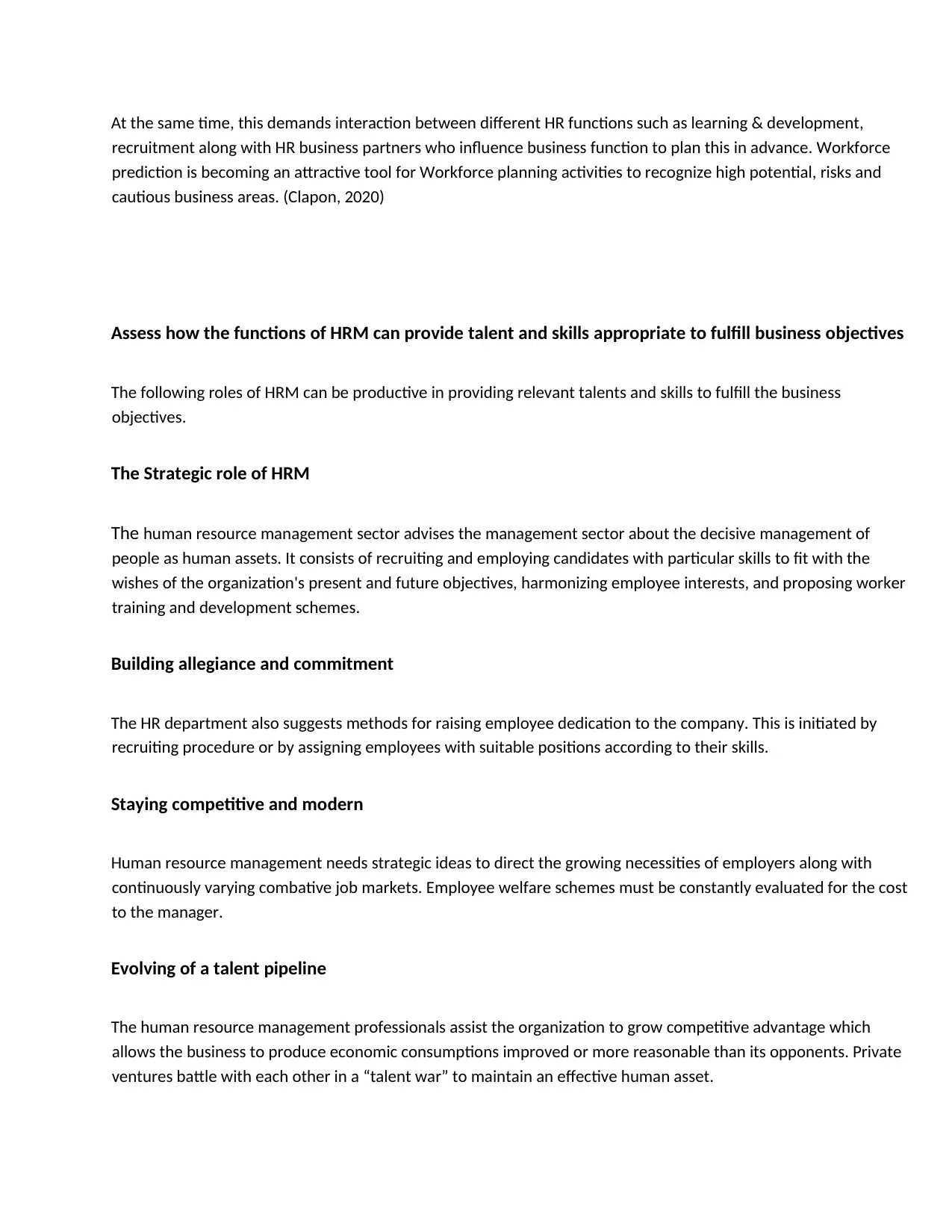
At the same time, this demands interaction between different HR functions such as learning & development,
recruitment along with HR business partners who influence business function to plan this in advance. Workforce
prediction is becoming an attractive tool for Workforce planning activities to recognize high potential, risks and
cautious business areas. (Clapon, 2020)
Assess how the functions of HRM can provide talent and skills appropriate to fulfill business objectives
The following roles of HRM can be productive in providing relevant talents and skills to fulfill the business
objectives.
The Strategic role of HRM
The human resource management sector advises the management sector about the decisive management of
people as human assets. It consists of recruiting and employing candidates with particular skills to fit with the
wishes of the organization's present and future objectives, harmonizing employee interests, and proposing worker
training and development schemes.
Building allegiance and commitment
The HR department also suggests methods for raising employee dedication to the company. This is initiated by
recruiting procedure or by assigning employees with suitable positions according to their skills.
Staying competitive and modern
Human resource management needs strategic ideas to direct the growing necessities of employers along with
continuously varying combative job markets. Employee welfare schemes must be constantly evaluated for the cost
to the manager.
Evolving of a talent pipeline
The human resource management professionals assist the organization to grow competitive advantage which
allows the business to produce economic consumptions improved or more reasonable than its opponents. Private
ventures battle with each other in a “talent war” to maintain an effective human asset.
recruitment along with HR business partners who influence business function to plan this in advance. Workforce
prediction is becoming an attractive tool for Workforce planning activities to recognize high potential, risks and
cautious business areas. (Clapon, 2020)
Assess how the functions of HRM can provide talent and skills appropriate to fulfill business objectives
The following roles of HRM can be productive in providing relevant talents and skills to fulfill the business
objectives.
The Strategic role of HRM
The human resource management sector advises the management sector about the decisive management of
people as human assets. It consists of recruiting and employing candidates with particular skills to fit with the
wishes of the organization's present and future objectives, harmonizing employee interests, and proposing worker
training and development schemes.
Building allegiance and commitment
The HR department also suggests methods for raising employee dedication to the company. This is initiated by
recruiting procedure or by assigning employees with suitable positions according to their skills.
Staying competitive and modern
Human resource management needs strategic ideas to direct the growing necessities of employers along with
continuously varying combative job markets. Employee welfare schemes must be constantly evaluated for the cost
to the manager.
Evolving of a talent pipeline
The human resource management professionals assist the organization to grow competitive advantage which
allows the business to produce economic consumptions improved or more reasonable than its opponents. Private
ventures battle with each other in a “talent war” to maintain an effective human asset.
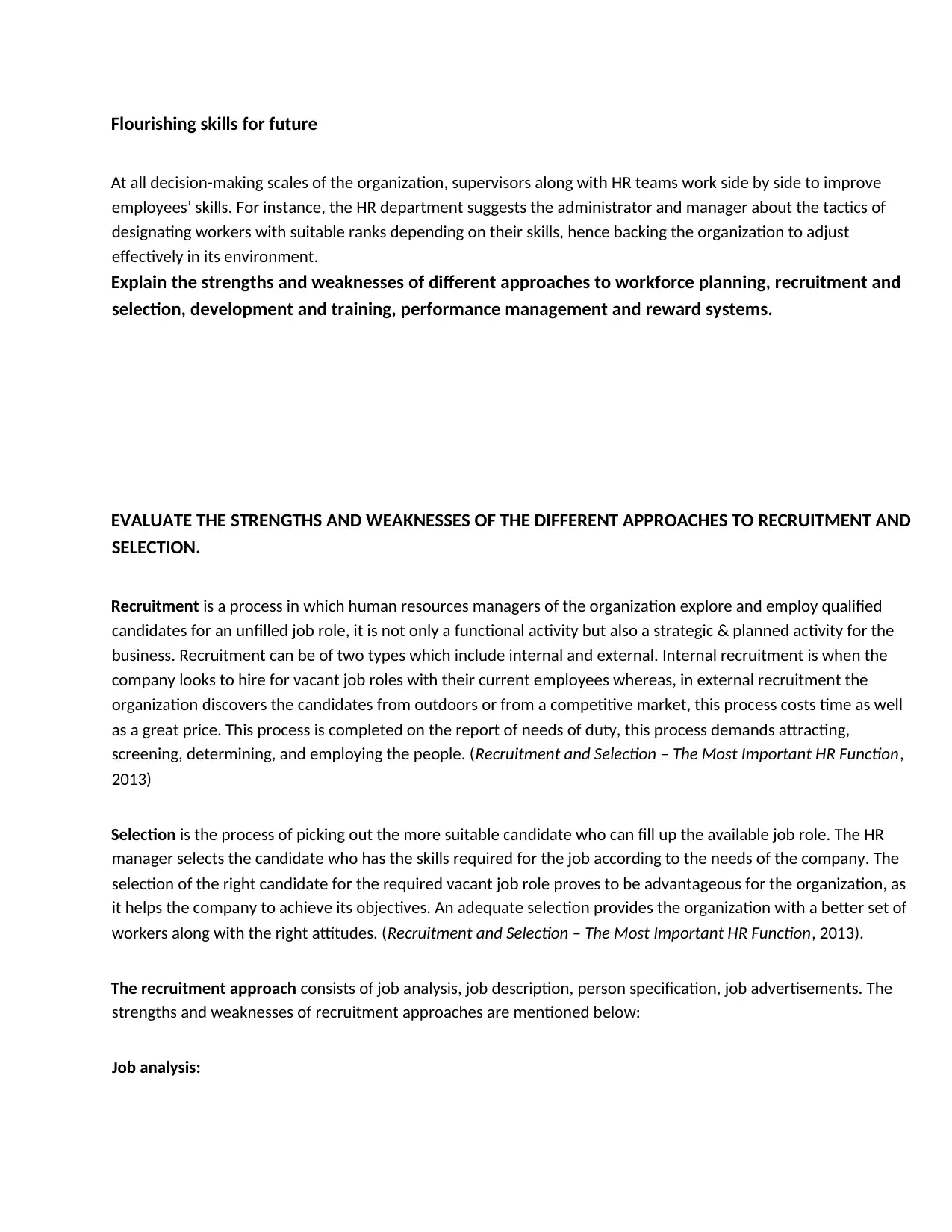
Flourishing skills for future
At all decision-making scales of the organization, supervisors along with HR teams work side by side to improve
employees’ skills. For instance, the HR department suggests the administrator and manager about the tactics of
designating workers with suitable ranks depending on their skills, hence backing the organization to adjust
effectively in its environment.
Explain the strengths and weaknesses of different approaches to workforce planning, recruitment and
selection, development and training, performance management and reward systems.
EVALUATE THE STRENGTHS AND WEAKNESSES OF THE DIFFERENT APPROACHES TO RECRUITMENT AND
SELECTION.
Recruitment is a process in which human resources managers of the organization explore and employ qualified
candidates for an unfilled job role, it is not only a functional activity but also a strategic & planned activity for the
business. Recruitment can be of two types which include internal and external. Internal recruitment is when the
company looks to hire for vacant job roles with their current employees whereas, in external recruitment the
organization discovers the candidates from outdoors or from a competitive market, this process costs time as well
as a great price. This process is completed on the report of needs of duty, this process demands attracting,
screening, determining, and employing the people. (Recruitment and Selection – The Most Important HR Function,
2013)
Selection is the process of picking out the more suitable candidate who can fill up the available job role. The HR
manager selects the candidate who has the skills required for the job according to the needs of the company. The
selection of the right candidate for the required vacant job role proves to be advantageous for the organization, as
it helps the company to achieve its objectives. An adequate selection provides the organization with a better set of
workers along with the right attitudes. (Recruitment and Selection – The Most Important HR Function, 2013).
The recruitment approach consists of job analysis, job description, person specification, job advertisements. The
strengths and weaknesses of recruitment approaches are mentioned below:
Job analysis:
At all decision-making scales of the organization, supervisors along with HR teams work side by side to improve
employees’ skills. For instance, the HR department suggests the administrator and manager about the tactics of
designating workers with suitable ranks depending on their skills, hence backing the organization to adjust
effectively in its environment.
Explain the strengths and weaknesses of different approaches to workforce planning, recruitment and
selection, development and training, performance management and reward systems.
EVALUATE THE STRENGTHS AND WEAKNESSES OF THE DIFFERENT APPROACHES TO RECRUITMENT AND
SELECTION.
Recruitment is a process in which human resources managers of the organization explore and employ qualified
candidates for an unfilled job role, it is not only a functional activity but also a strategic & planned activity for the
business. Recruitment can be of two types which include internal and external. Internal recruitment is when the
company looks to hire for vacant job roles with their current employees whereas, in external recruitment the
organization discovers the candidates from outdoors or from a competitive market, this process costs time as well
as a great price. This process is completed on the report of needs of duty, this process demands attracting,
screening, determining, and employing the people. (Recruitment and Selection – The Most Important HR Function,
2013)
Selection is the process of picking out the more suitable candidate who can fill up the available job role. The HR
manager selects the candidate who has the skills required for the job according to the needs of the company. The
selection of the right candidate for the required vacant job role proves to be advantageous for the organization, as
it helps the company to achieve its objectives. An adequate selection provides the organization with a better set of
workers along with the right attitudes. (Recruitment and Selection – The Most Important HR Function, 2013).
The recruitment approach consists of job analysis, job description, person specification, job advertisements. The
strengths and weaknesses of recruitment approaches are mentioned below:
Job analysis:
⊘ This is a preview!⊘
Do you want full access?
Subscribe today to unlock all pages.

Trusted by 1+ million students worldwide
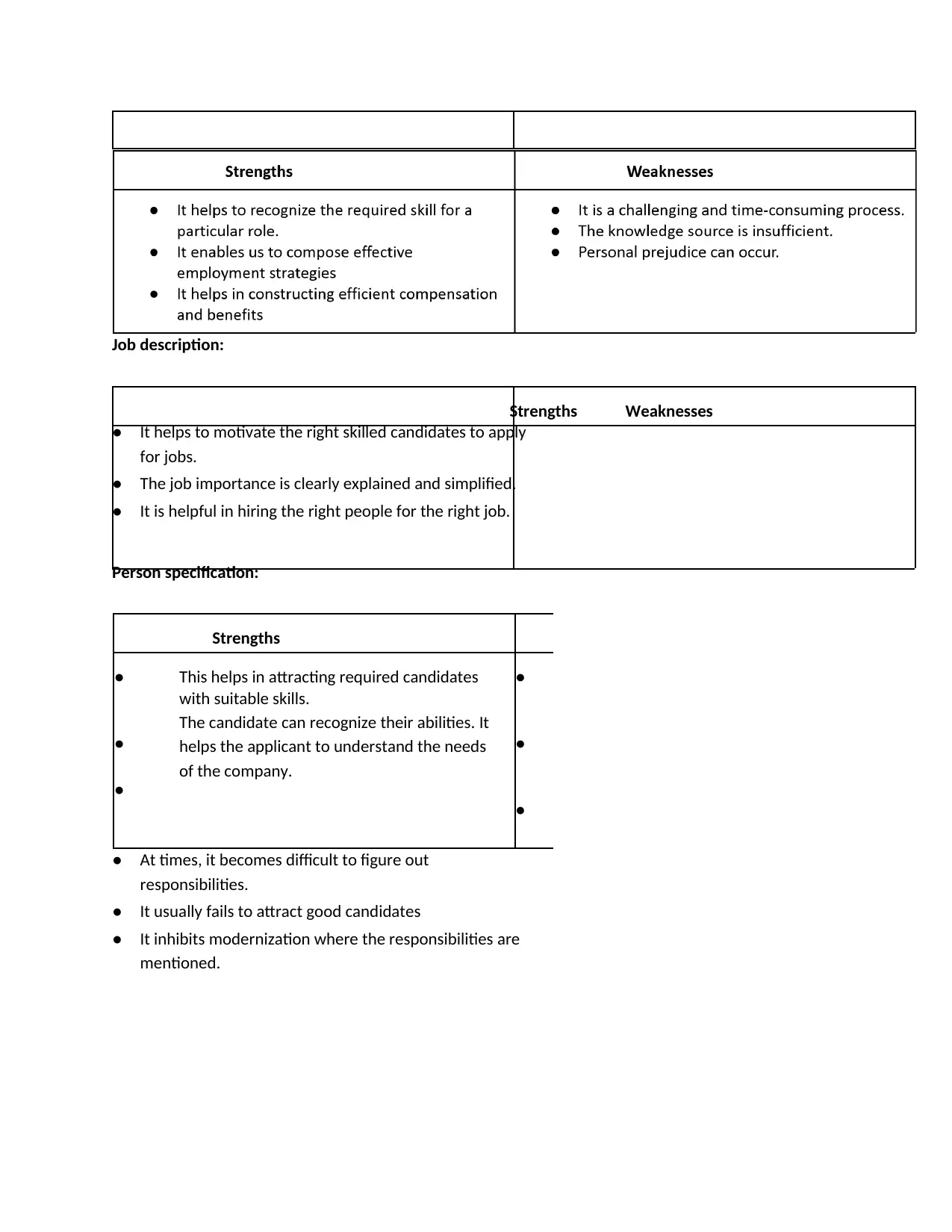
Job description:
Strengths Weaknesses
● It helps to motivate the right skilled candidates to apply
for jobs.
● The job importance is clearly explained and simplified.
● It is helpful in hiring the right people for the right job.
Person specification:
Strengths
●
●
●
This helps in attracting required candidates
with suitable skills.
The candidate can recognize their abilities. It
helps the applicant to understand the needs
of the company.
●
●
●
● At times, it becomes difficult to figure out
responsibilities.
● It usually fails to attract good candidates
● It inhibits modernization where the responsibilities are
mentioned.
Strengths Weaknesses
● It helps to motivate the right skilled candidates to apply
for jobs.
● The job importance is clearly explained and simplified.
● It is helpful in hiring the right people for the right job.
Person specification:
Strengths
●
●
●
This helps in attracting required candidates
with suitable skills.
The candidate can recognize their abilities. It
helps the applicant to understand the needs
of the company.
●
●
●
● At times, it becomes difficult to figure out
responsibilities.
● It usually fails to attract good candidates
● It inhibits modernization where the responsibilities are
mentioned.
Paraphrase This Document
Need a fresh take? Get an instant paraphrase of this document with our AI Paraphraser
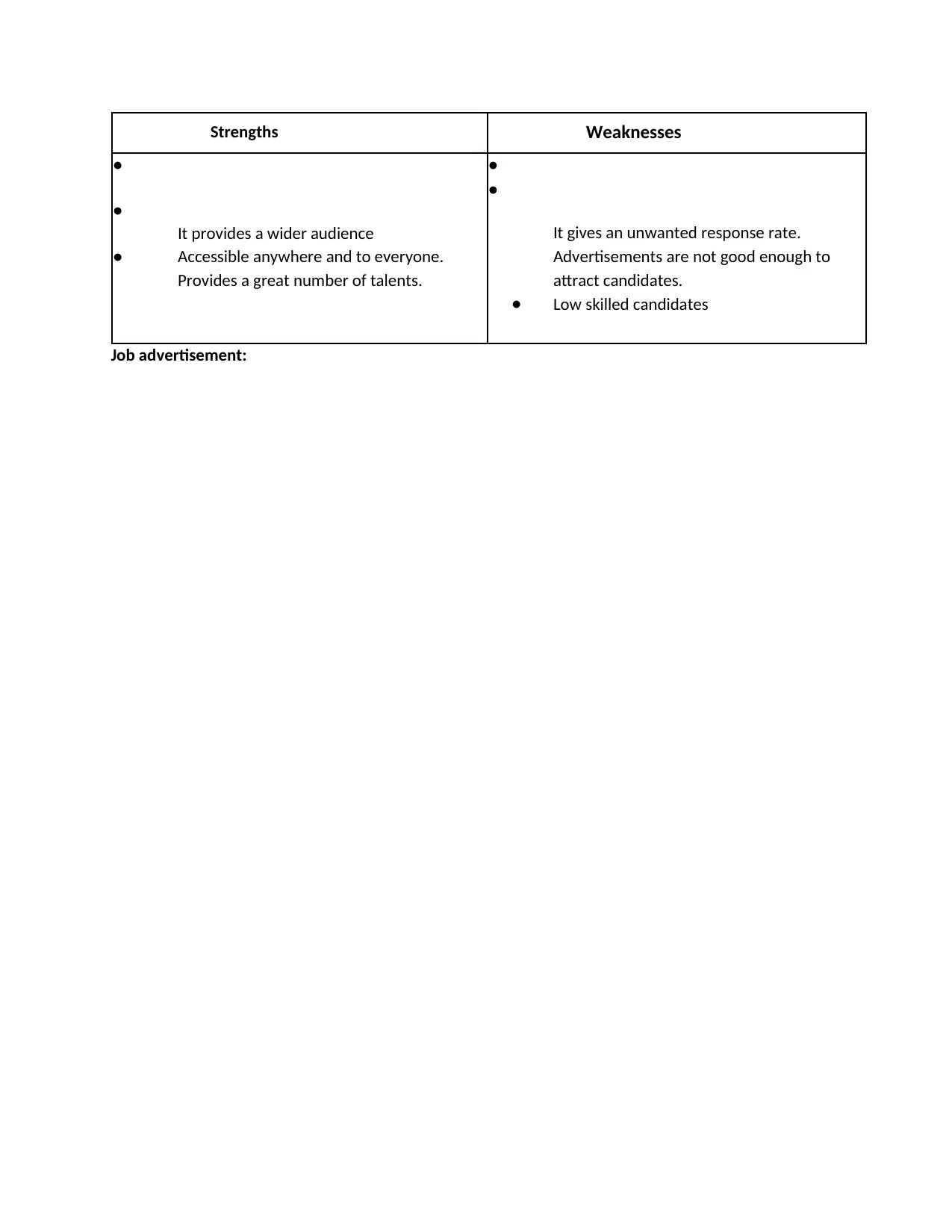
Strengths Weaknesses
●
●
●
It provides a wider audience
Accessible anywhere and to everyone.
Provides a great number of talents.
●
●
It gives an unwanted response rate.
Advertisements are not good enough to
attract candidates.
● Low skilled candidates
Job advertisement:
●
●
●
It provides a wider audience
Accessible anywhere and to everyone.
Provides a great number of talents.
●
●
It gives an unwanted response rate.
Advertisements are not good enough to
attract candidates.
● Low skilled candidates
Job advertisement:
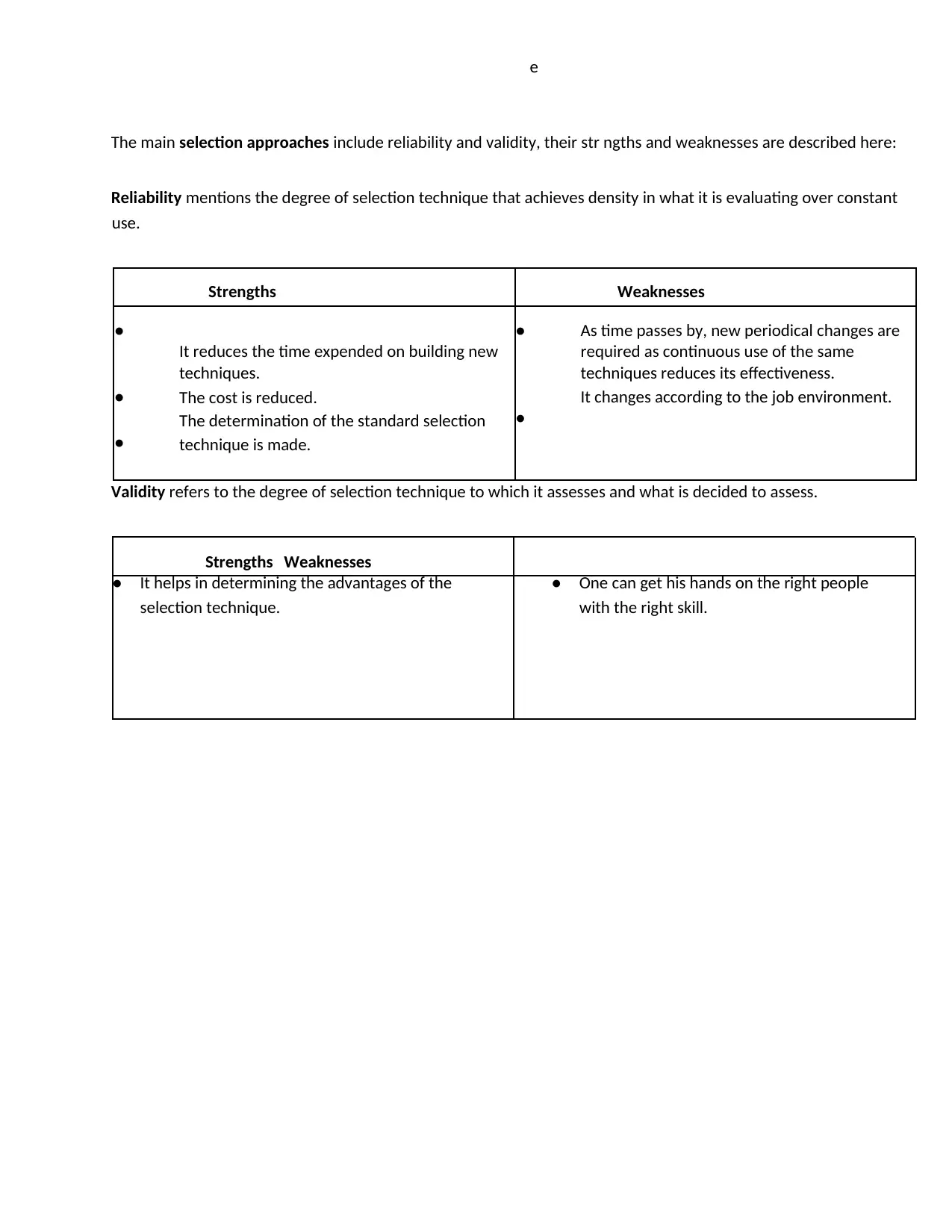
e
The main selection approaches include reliability and validity, their str ngths and weaknesses are described here:
Reliability mentions the degree of selection technique that achieves density in what it is evaluating over constant
use.
Strengths Weaknesses
●
●
●
It reduces the time expended on building new
techniques.
The cost is reduced.
The determination of the standard selection
technique is made.
●
●
As time passes by, new periodical changes are
required as continuous use of the same
techniques reduces its effectiveness.
It changes according to the job environment.
Validity refers to the degree of selection technique to which it assesses and what is decided to assess.
Strengths Weaknesses
● It helps in determining the advantages of the
selection technique.
● One can get his hands on the right people
with the right skill.
The main selection approaches include reliability and validity, their str ngths and weaknesses are described here:
Reliability mentions the degree of selection technique that achieves density in what it is evaluating over constant
use.
Strengths Weaknesses
●
●
●
It reduces the time expended on building new
techniques.
The cost is reduced.
The determination of the standard selection
technique is made.
●
●
As time passes by, new periodical changes are
required as continuous use of the same
techniques reduces its effectiveness.
It changes according to the job environment.
Validity refers to the degree of selection technique to which it assesses and what is decided to assess.
Strengths Weaknesses
● It helps in determining the advantages of the
selection technique.
● One can get his hands on the right people
with the right skill.
⊘ This is a preview!⊘
Do you want full access?
Subscribe today to unlock all pages.

Trusted by 1+ million students worldwide
1 out of 38
Related Documents
Your All-in-One AI-Powered Toolkit for Academic Success.
+13062052269
info@desklib.com
Available 24*7 on WhatsApp / Email
![[object Object]](/_next/static/media/star-bottom.7253800d.svg)
Unlock your academic potential
Copyright © 2020–2025 A2Z Services. All Rights Reserved. Developed and managed by ZUCOL.




